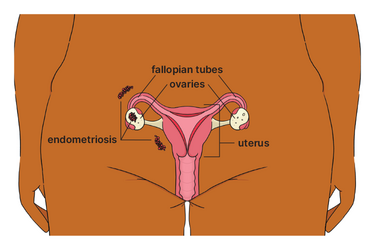People with endometriosis can have different symptoms. The severity of symptoms is not related to the number or extent of endometriosis lesions a person has.
Different factors can cause endometriosis symptoms to get better or worse over time. For example, treatments, age and a person’s environment.
On this page, you’ll learn more about common symptoms of endometriosis and what may increase the likelihood of developing the condition.
Symptoms of endometriosis
Causes of endometriosis
Risk factors for endometriosis
Can you prevent endometriosis?
Endometriosis and other health conditions
When to see your doctor about endometriosis symptoms
Common symptoms of endometriosis include:
Less common symptoms include:
Endometriosis symptoms often improve after menopause due to the drop in oestrogen hormone levels.
But menopause is not a ‘cure’ for endometriosis. Some women continue to have symptoms after natural or medically induced menopause.
If you have endometriosis and are using menopausal hormone therapy (MHT) to manage menopausal symptoms, it’s recommended you use combined MHT rather than oestrogen-only MHT.
Some women who have endometriosis also have persistent pelvic pain (PPP). PPP is pain in your pelvic area that’s felt most days and lasts for more than 6 months.
If your endometriosis symptoms stop you from doing day-to-day activities, for example, work, study or exercise, see your doctor. It’s also a good idea to see your doctor if your symptoms are getting worse or making you feel anxious or depressed.
It’s not yet known exactly how and why some women develop endometriosis. It’s a complex condition that depends on the oestrogen hormone. But it may also be influenced by other factors.
When you have a period, blood flows out of your vagina. But it can also flow backwards along your fallopian tubes into your pelvic area. Nearly all women experience this, but the blood (which contains endometrial cells) is usually absorbed or broken down in the body. In some women, the endometrial tissue starts to grow and form lesions.

Genetics play an important role, but genetics don’t fully explain why some women develop endometriosis and others don’t.
Researchers are looking at different factors that might cause endometriosis. For example, how the immune and hormone systems interact.
We need more research to show how genetics can increase the risk for endometriosis, and to identify the genes involved. Other factors that might increase your risk for endometriosis include:
The risk of endometriosis developing may also decrease with each pregnancy. This might be due to an increase in the progesterone hormone in the body during pregnancy.
There is no known way to prevent endometriosis. We need more research to understand what actions might help to reduce the risk of developing the condition.
Some other health conditions are more likely in women with endometriosis, but we need more research to better understand this. It’s helpful to be aware of the links, but it doesn’t mean you will develop these conditions:
Pain is a common symptom of endometriosis. But it’s not normal to have severe period pain.
If you think you have endometriosis, see your doctor as soon as possible.
Your doctor may ask questions about:
You might also like to read our Seeing your doctor about persistent pelvic pain fact sheet.
This content has been reviewed by a group of medical subject matter experts, in accordance with Jean Hailes policy.
© Jean Hailes Foundation. All rights reserved.